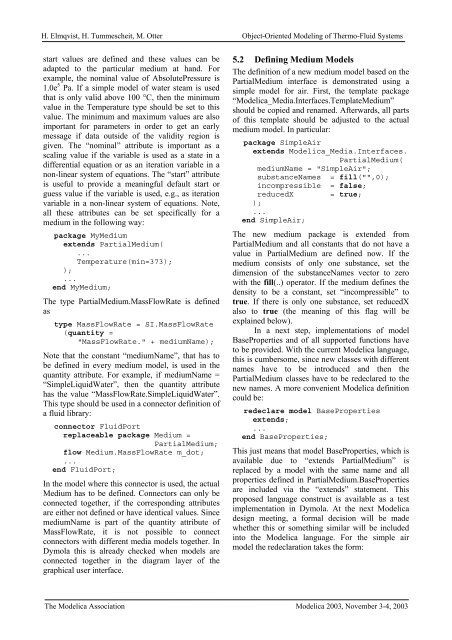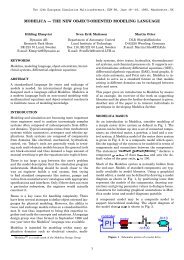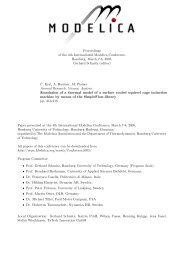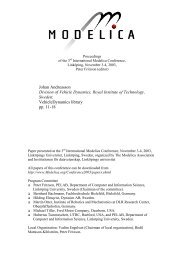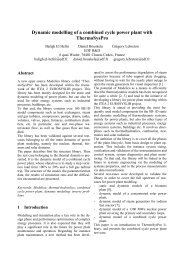Hilding Elmqvist, Hubertus Tummescheit and Martin Otter ... - Modelica
Hilding Elmqvist, Hubertus Tummescheit and Martin Otter ... - Modelica
Hilding Elmqvist, Hubertus Tummescheit and Martin Otter ... - Modelica
You also want an ePaper? Increase the reach of your titles
YUMPU automatically turns print PDFs into web optimized ePapers that Google loves.
H. <strong>Elmqvist</strong>, H. <strong>Tummescheit</strong>, M. <strong>Otter</strong> Object-Oriented Modeling of Thermo-Fluid Systems<br />
start values are defined <strong>and</strong> these values can be<br />
adapted to the particular medium at h<strong>and</strong>. For<br />
example, the nominal value of AbsolutePressure is<br />
1.0e 5 Pa. If a simple model of water steam is used<br />
that is only valid above 100 °C, then the minimum<br />
value in the Temperature type should be set to this<br />
value. The minimum <strong>and</strong> maximum values are also<br />
important for parameters in order to get an early<br />
message if data outside of the validity region is<br />
given. The “nominal” attribute is important as a<br />
scaling value if the variable is used as a state in a<br />
differential equation or as an iteration variable in a<br />
non-linear system of equations. The “start” attribute<br />
is useful to provide a meaningful default start or<br />
guess value if the variable is used, e.g., as iteration<br />
variable in a non-linear system of equations. Note,<br />
all these attributes can be set specifically for a<br />
medium in the following way:<br />
package MyMedium<br />
extends PartialMedium(<br />
...<br />
Temperature(min=373);<br />
);<br />
...<br />
end MyMedium;<br />
The type PartialMedium.MassFlowRate is defined<br />
as<br />
type MassFlowRate = SI.MassFlowRate<br />
(quantity =<br />
"MassFlowRate." + mediumName);<br />
Note that the constant “mediumName”, that has to<br />
be defined in every medium model, is used in the<br />
quantity attribute. For example, if mediumName =<br />
“SimpleLiquidWater”, then the quantity attribute<br />
has the value “MassFlowRate.SimpleLiquidWater”.<br />
This type should be used in a connector definition of<br />
a fluid library:<br />
connector FluidPort<br />
replaceable package Medium =<br />
PartialMedium;<br />
flow Medium.MassFlowRate m_dot;<br />
...<br />
end FluidPort;<br />
In the model where this connector is used, the actual<br />
Medium has to be defined. Connectors can only be<br />
connected together, if the corresponding attributes<br />
are either not defined or have identical values. Since<br />
mediumName is part of the quantity attribute of<br />
MassFlowRate, it is not possible to connect<br />
connectors with different media models together. In<br />
Dymola this is already checked when models are<br />
connected together in the diagram layer of the<br />
graphical user interface.<br />
5.2 Defining Medium Models<br />
The definition of a new medium model based on the<br />
PartialMedium interface is demonstrated using a<br />
simple model for air. First, the template package<br />
“<strong>Modelica</strong>_Media.Interfaces.TemplateMedium”<br />
should be copied <strong>and</strong> renamed. Afterwards, all parts<br />
of this template should be adjusted to the actual<br />
medium model. In particular:<br />
package SimpleAir<br />
extends <strong>Modelica</strong>_Media.Interfaces.<br />
PartialMedium(<br />
mediumName = "SimpleAir";<br />
substanceNames = fill("",0);<br />
incompressible = false;<br />
reducedX = true;<br />
);<br />
...<br />
end SimpleAir;<br />
The new medium package is extended from<br />
PartialMedium <strong>and</strong> all constants that do not have a<br />
value in PartialMedium are defined now. If the<br />
medium consists of only one substance, set the<br />
dimension of the substanceNames vector to zero<br />
with the fill(..) operator. If the medium defines the<br />
density to be a constant, set “incompressible” to<br />
true. If there is only one substance, set reducedX<br />
also to true (the meaning of this flag will be<br />
explained below).<br />
In a next step, implementations of model<br />
BaseProperties <strong>and</strong> of all supported functions have<br />
to be provided. With the current <strong>Modelica</strong> language,<br />
this is cumbersome, since new classes with different<br />
names have to be introduced <strong>and</strong> then the<br />
PartialMedium classes have to be redeclared to the<br />
new names. A more convenient <strong>Modelica</strong> definition<br />
could be:<br />
redeclare model BaseProperties<br />
extends;<br />
...<br />
end BaseProperties;<br />
This just means that model BaseProperties, which is<br />
available due to “extends PartialMedium” is<br />
replaced by a model with the same name <strong>and</strong> all<br />
properties defined in PartialMedium.BaseProperties<br />
are included via the “extends” statement. This<br />
proposed language construct is available as a test<br />
implementation in Dymola. At the next <strong>Modelica</strong><br />
design meeting, a formal decision will be made<br />
whether this or something similar will be included<br />
into the <strong>Modelica</strong> language. For the simple air<br />
model the redeclaration takes the form:<br />
The <strong>Modelica</strong> Association <strong>Modelica</strong> 2003, November 3-4, 2003


